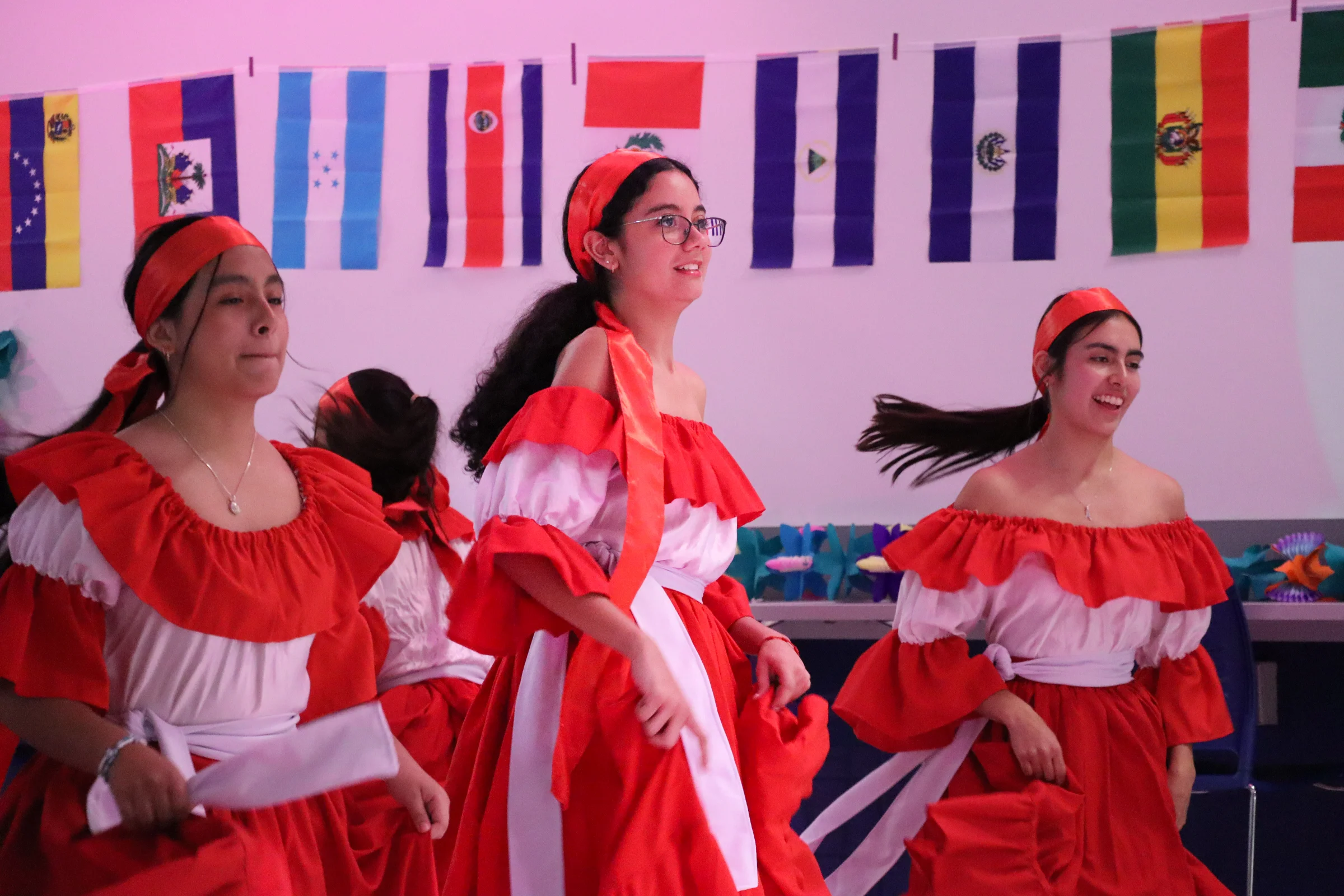PHS French and Spanish students welcome exchange students from France and Peru
October, 2025
Photo: Katherine Chen
Peruvian exchange students Brianna Quevedo, Antonella Cayo, and Andrea Rucoba Pedreschi perform traditional Peruvian dance.
Lima, Peru
On Friday, October 10, 14 exchange students from a district just outside Lima, Peru arrived at PHS, beginning their nearly two-week long visit to Princeton designed to help them explore American culture and develop bilingualism. The Peruvians had a packed schedule of activities: including trips to destinations within Princeton and to multiple attractions within New York City, and the Robbinsville BAPS Swaminarayan Akshardham Hindu Temple.
“I think our host [did] things to [help us] have the feeling of home ... I went to Philadelphia last Sunday…and I had a lot of fun there ... I [also] spent time with the family ... playing some basketball... and some Monopoly,” said Nicholas Bautista, one of the exchange students.
The exchange students, all currently freshmen, call the Surco district of Lima home, an urban district with a population of nearly 400,000. The students attend San José Monterrico, a small private bilingual school with about 900 students across grades K-12. They are the first batch of students at their school to be part of the International Baccalaureate (IB) program, a two-year educational program analogous to AP curriculums.
“I’m very excited, but a little bit scared because … our teacher said that it’s very hard to do,” said Renzo Ghersi, one of the students from Peru. “I think, personally, I will handle that, but I’m kind of scared about the exam because although we do it in two years from now...it’s really difficult and not all people get their diplomas."
Luciana Bedregal, Mateo Esterripa, along with Ghersi and Bautista, all showed a particular leaning towards STEM fields — noting that physics, math, and chemistry were their favorite subjects in school. However, they also pointed out their school offers a wide variety of required social science classes which differ from offerings at PHS. Most of the classes at their school are taught in Spanish, with the exception of world history, which is taught in English. The exchange trips PHS hosts, in the eyes of PHS Spanish teacher Idania Rodriguez-Mejia,
are critical to advancing cultural knowledge of the language. “[There’s] nothing better than learning about other people’s beliefs firsthand. They’re coming from Peru and they are bringing with them who they are and their own unique identity.” said Rodriguez. “When students go to Peru, they do the same…that alone creates community, open-mindedness and learning.”
Colmar, France
Celeste Lengrand was one of 44 students from Colmar, France who visited Princeton this October while staying with a family of a French-learning PHS student.
“It’s like an American series with the yellow buses ... [and] the lockers,” said Lengrand.
Colmar’s relationship with Princeton as a “sister-city” dates far beyond this exchange trip. The connection was initiated in 1986 by late Princeton Mayor Barbara B. Sigmund during the celebration of the Statue of Liberty’s 100th anniversary. Since then, the trip has been a lasting connection between the two cities.
“The fact that they can develop a rapport, a relationship, a friendship is the most valuable thing,” said Malachi Wood, the French teacher responsible for coordinating the exchange. “At the very end of the exchange when we’re leaving, it’s nice to see all the kids crying and sad because they made a solid connection.”
During their 11-day trip to Princeton, students from Lycée Bartholdi had the chance to immerse themselves in the history of Princeton, the United States, and France.
“When they come here, we focus on American history. We’re doing a little presentation about Lafayette [and] we’re going to see the local, historical sites in town … we always try to hit Morven, Drumthwacket, Updike Farmhouse. And when we go to France, we focus on the War of 1870, World War I, World War II, and the aftermath,” said Wood.
Though America and France have long been close political and economic allies, Lengrand observed the value of direct interaction between French and American students.
“I think it’s important to see we are not alone in the world and see different points of view, for example [with] politics, because in France, we have a view of politics [of] the America, and [we can] see the view[s] of people [who] live in America,” said Lengrand.
PHS students take reciprocal trips to Colmar at the end of October, where they can immerse themselves in French culture and schooling. Elif Cam ’26, one of the PHS host students, explained how having the chance to attend the trip while learning about various aspects of French culture creates a lived experience unparalleled in the classroom.
“I think it’s such a crucial part of the language learning experience that is just so different from everything else you do in class,” said Cam. “You study French culture. You study [how] [their] way of life is different…but it’s not the same thing as actually interacting with people who are from the culture.”